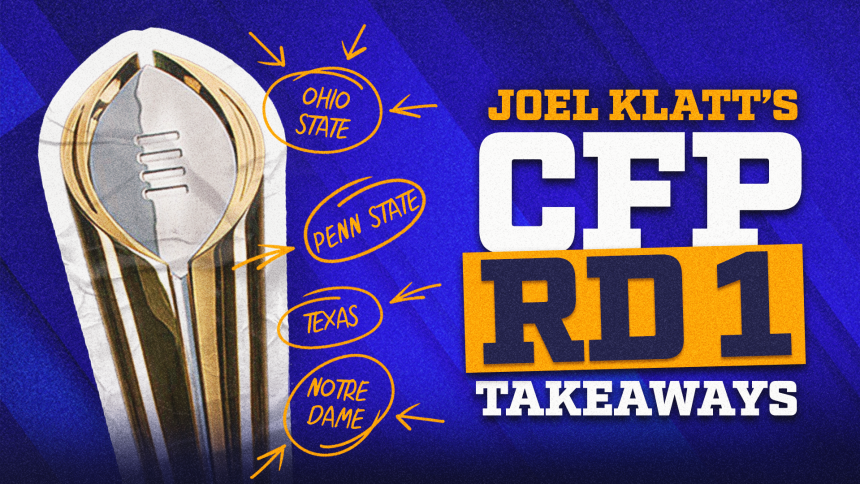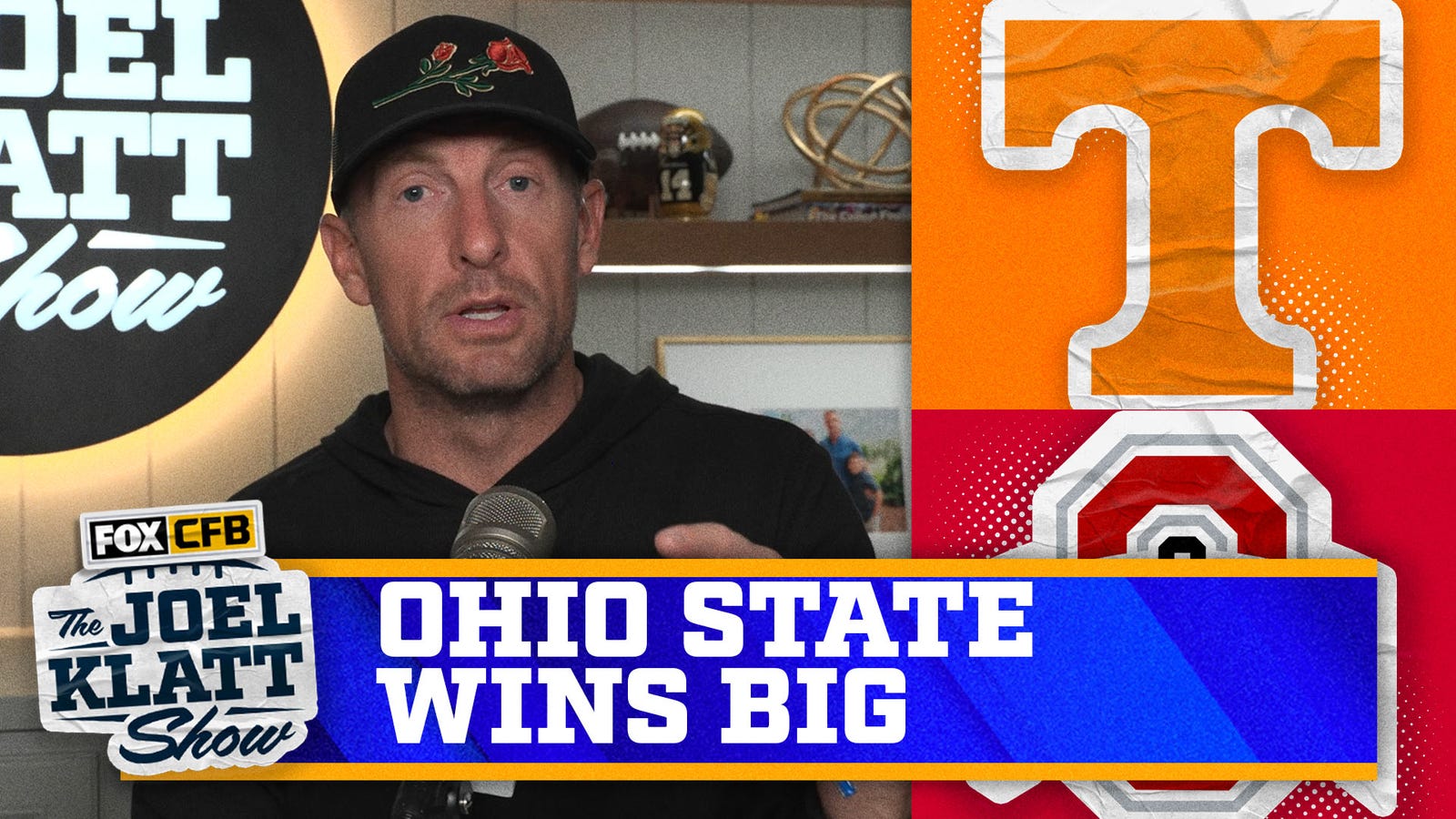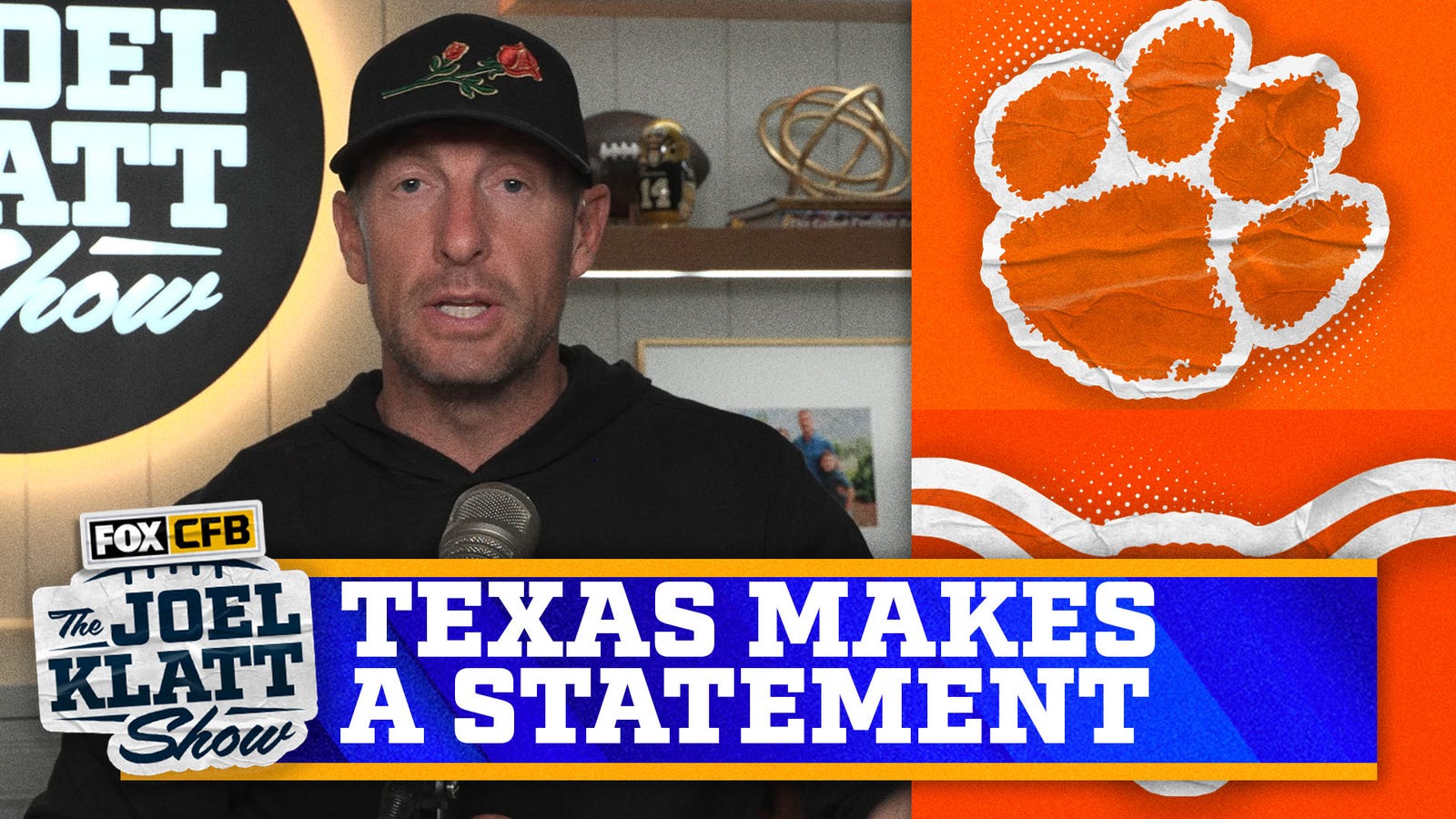This weekend was awesome for college football.
The first round of the inaugural edition of the 12-team playoff was phenomenal. I understand the games weren’t as competitive as we hoped for, but it was amazing to see these high-stakes matchups played at on-campus sites.
We’ve been waiting for this weekend all season long. No one can argue that the expanded College Football Playoff didn’t make the regular season better. We finally got to watch playoff games unfold at some of the most iconic venues after watching teams fight tooth and nail this fall to position themselves as a host.
So, if you love this sport like I do, you enjoyed this weekend even if there wasn’t an exciting finish. Here are my five takeaways from the first round of the CFP.
ADVERTISEMENT
Ohio State gave the performance we’ve been waiting for.
That was such an impressive showing from Ohio State. It also looked so much different than the last time we saw it take the field. Ahead of Saturday’s tilt, I mentioned Ryan Day’s track record of fixing issues following losses, especially ahead of CFP games. Day and Chip Kelly understood that their game plan for the Michigan game was a poor one, opting not to play in space and along the perimeter in that game.
So, Day and Kelly did exactly what I thought they’d do. They went up-tempo and played more in space against Tennessee. Ohio State’s offense was like an avalanche with how aggressive it was in the first quarter, and Tennessee didn’t stand a chance. The Volunteers didn’t have the requisite talent in the secondary to match up with the Buckeyes’ wide receivers, and the aggressive play-calling didn’t allow them to ever really settle in.
That game plan is how Ohio State should live moving forward. It doesn’t have to prove to anyone that it can run the ball. Go play in space, and you have one of the best offenses in the country. This was the offense we’ve wanted to see all along as well, with Ohio State playing a bit slow to ramp up for a possible long postseason run. In the conversations I’ve had with Day and Kelly since spring, they mentioned the idea of wanting to pace themselves through the season so that they’re ready to go from a schematic and freshness standpoint late in the year. They knew they’d have to play 16 games to win a national championship.
Ohio State is at its best when it’s playing up-tempo and in space. I know it doesn’t want to play that way all the time, but that’s when it’s at its best — and it is incredibly difficult to stop.
Defensively, Ohio State was totally dominant. Tennessee RB Dylan Sampson’s bizarre situation compounded things for the Vols, but the Buckeyes defense played one of the more unique game plans they’ve played all season. Tennessee’s spread offense is pretty rare throughout the college football landscape, where it plays the numbers game based on how the defense is aligned. Ohio State played soft pass coverage for much of the game, and it told its front six to handle the run game and generate pressure. That forced Tennessee’s Nico Iamaleava to hold the ball, allowing Ohio State’s pass rush to get to the quarterback. With Sampson out, Tennessee was never able to run the football, which was the only way it would’ve been able to get Ohio State out of that defensive structure.
Ohio State proved why its spot as the top total and scoring defense is legit. Tennessee couldn’t generate many positive plays offensively, causing Iamaleava to unsuccessfully put his superhero cape on. When Ohio State plays this way, it’s virtually unbeatable. Now, top-seeded Oregon must play this Ohio State team, which is wild.
Texas shined in the trenches to edge Clemson‘s valiant effort.
It was always going to be a hearty ask of Clemson to somehow pull off an upset over Texas in Austin. Considering its blowout loss in Week 1, I don’t think any of us thought Clemson would even get to play in the CFP. It really earned its way into the playoff and had the best performance of the four road teams over the weekend. QB Cade Klubnik turned into Superman for Clemson in that game, giving the Tigers a chance to pull off an upset.
Texas’ balance makes it a scary team and that’s why I thought it’d be tough for Clemson to win. But the Longhorns won the game due to the battle at the line of scrimmage. It forced Klubnik to have to do too much because Clemson couldn’t stop the run. Jaydon Blue‘s 77-yard touchdown run for the Longhorns ended up being the back-breaker, but Texas had 292 rushing yards to Clemson’s 76. Rushing totals can be wonky, but Texas rushed for 6.1 yards per carry and Clemson rushed for just 3.2 yards per carry. Clemson just couldn’t get a stop.
The big question entering this game was how well Texas’ offense would play after some underwhelming performances last in the regular season, and would Quinn Ewers break out of the slump he was in? I admittedly had my doubts about the Longhorns’ offense and Ewers ahead of the game, but the offensive line showed up, allowing the run game to get going and Ewers to be comfortable. When Texas is losing, it feels like Steve Sarkisian has to scheme guys open a lot for Ewers because he can’t throw guys open as well as the elite quarterbacks.
So, Texas winning the way it did was encouraging. It can win the track meet or the slugfest. It should beat fourth-seeded Arizona State in the Peach Bowl. Texas, whose defense is second-best in the nation in a lot of ways, has to focus on ASU RB Cam Skattebo, as leading receiver Jordan Tyson is out for the season. Offensively, Texas has to run the football. If it doesn’t place the entire game on Ewers’ shoulders, Texas should be able to handily beat ASU.
SMU made costly errors, but Penn State‘s progression continued.
Like the first two games mentioned, the road team failed to run the football. Of course, SMU QB Kevin Jennings gifted Penn State a 14-point advantage with two pick-sixes, but the game was over at that point because the Mustangs weren’t coming back from that deficit in that environment.
Penn State’s defense held SMU’s offense to just 1.6 yards per carry. So, SMU was doing nothing on the ground and Jennings was seeing ghosts. There was no Mustang in the vicinity of the interception he threw to Penn State’s Tony Rojas. With that, SMU’s magical season was done.
As for Penn State, it’s playing its best football right now. I thought that after the Big Ten title loss. The big knock against James Franklin in his tenure at Happy Valley has been Penn State’s performances against the elite group of teams. Even though Penn State didn’t beat Ohio State or Oregon earlier this year, I felt like those losses were the best performances it put up in those sorts of games since it last won the Big Ten in 2016. It played a way in both of those games that made me think, “I could see it winning one of those big games later this year.”
So, Penn State’s performance Saturday wasn’t even all that pretty, and it still won handily. Looking forward, it has a super athletic defense that brings a lot of pressure combined with an offense that Franklin has hoped it would do. Franklin brought in Andy Kotelnicki as offensive coordinator because he wanted to be more explosive against better competition. Franklin also wanted to get his offensive stars the ball in big moments. Kotelnicki struggled to do that against Ohio State, but he successfully did it against Oregon and again in its win over SMU.
This is a much better Penn State team than people realize. It also gets a great draw. There’s no doubt that Penn State is better than Boise State, who the Nittany Lions will face in the Fiesta Bowl. That doesn’t mean that they’ll win the game, but they have a great chance of getting to the semifinals.
Notre Dame impressed in win vs. Indiana and might have the blueprint to give Georgia problems.
Kurtis Rourke‘s interception in the first quarter caused a dramatic 14-point swing, like the two pick-sixes Jennings threw against PSU. Of course, Jeremiyah Love turned that interception into a 98-yard touchdown run to give Notre Dame an early 7-0 lead, and I thought Rourke was never the same after that. He didn’t play with the rhythm that I saw him play in any other game. You’ve got to give Notre Dame credit for that.
Notre Dame has one of the best defenses in the country and continuing the theme from the other three games, it took away the run from Indiana. The Hoosiers only ran the ball for 2.3 yards per carry. That’s not enough and it put too much on Rourke’s shoulders. Offensively, Notre Dame’s run game was too dynamic for Indiana and Riley Leonard has been playing better. Truth be told, I don’t think Leonard’s a great passer. I believe he’s serviceable, though, with talent at wide receiver, which I think is better than what people realize. Love was dealing with flu-like symptoms and wasn’t as effective after the touchdown run, but it didn’t matter because Notre Dame has good running back depth.
Looking forward, Georgia struggled against mobile quarterbacks this year, and that’s what Leonard is. What Leonard lacks as a passer, he certainly makes up for in his willingness and effectiveness at running the football. Notre Dame is sort of like a much better version of Hayes King and Georgia Tech. That doesn’t mean Georgia is going to lose. Kirby Smart always puts together a strong game plan, but Notre Dame is playing some great football and has a chance to take down the Bulldogs.
Home teams winning doesn’t mean we have to be upset with the new format.
It’s really hard to win on the road, especially when you’re taking on a top-five team. Remember, the four teams that played at home over the weekend were ranked third through sixth in the final CFP poll. We all believed that each of those teams at home was incredible all year long, too. Notre Dame and PSU are playing their best football right now. If Texas and Ohio State are also playing at their best, and the way they did Saturday proved they can win it all.
Why wasn’t that the prevailing discourse? There were plenty of folks in college football who treated the games as an indictment of the loser. This weekend should’ve been a celebration over what happened rather than focusing on the flawed teams, which you’re certainly going to have in a 12-team field.
I took issue with the criticisms dished out toward some of the losing teams this weekend. For those concerned by the margin of victories in each game, it’s nothing different from what we saw during the four-team playoff era. We had some absolute duds in those seminal and championship games. We saw Georgia beat TCU 65-7 to win the national title in 2023, so let’s not be revisionist and act like everything used to be incredible.
There are also large margins of victory in the NFL playoffs, too. In the first round of the postseason last year, the average margin of victory in those six games was 17.5 points and home teams went 5-1. Only one game was decided by a single score, yet we didn’t hear how any of those losing teams weren’t deserving of being in the playoffs.
That’s why I went at Lane Kiffin the way I did on social media during Saturday’s games. We should be celebrating the sport. I have respect for Kiffin (the coach and the tweeter), and I hope he remains in college football for a long time, but I dislike playing the hypothetical game because there’s no proving you wrong.
So, let’s enjoy the games and make sure we recognize why it’s hard to win playoff games, especially on the road.
Joel Klatt is FOX Sports’ lead college football game analyst and the host of the podcast “The Joel Klatt Show.” Follow him at @joelklatt and subscribe to the “Joel Klatt Show” on YouTube.
[Want great stories delivered right to your inbox? Create or log in to your FOX Sports account, follow leagues, teams and players to receive a personalized newsletter daily.]
recommended

Get more from College Football Follow your favorites to get information about games, news and more














